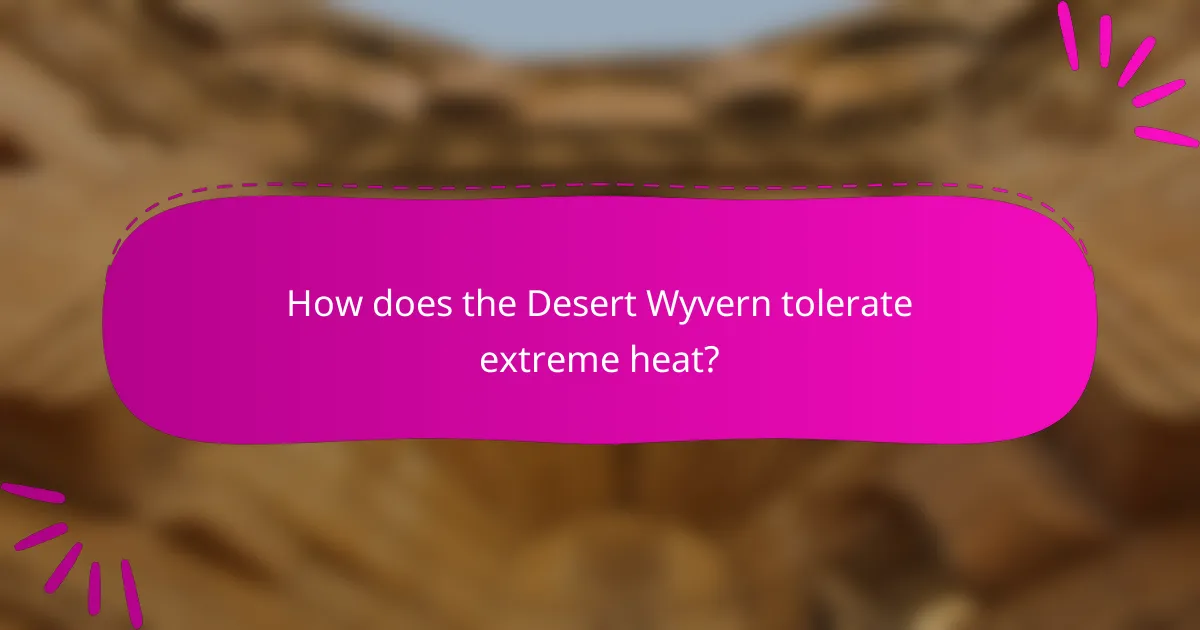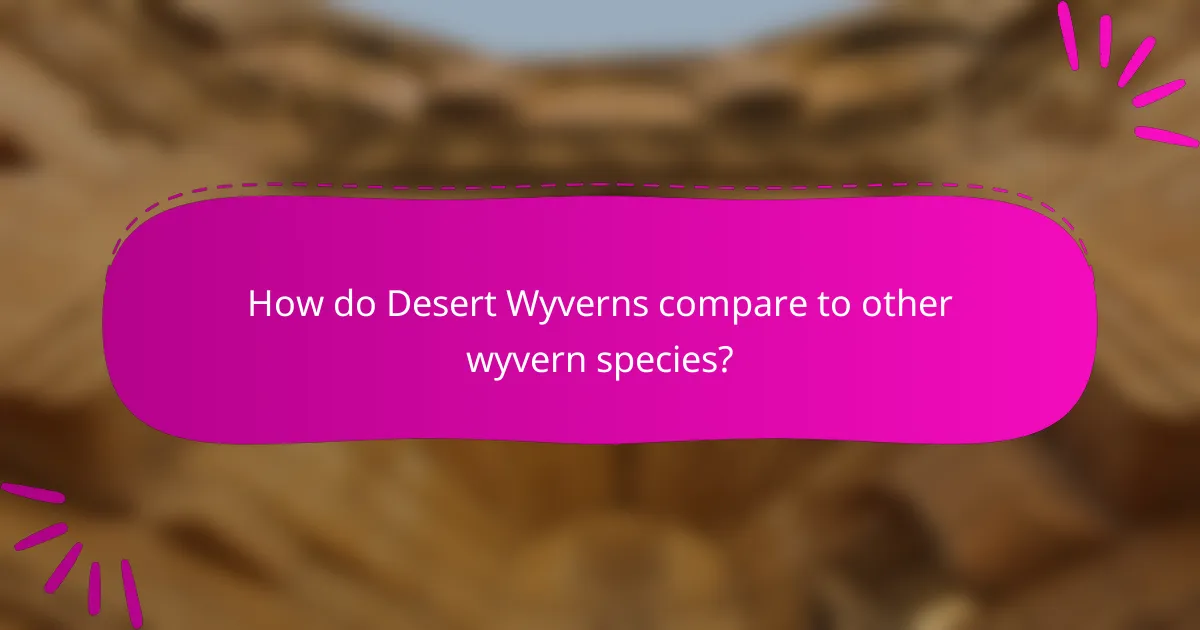The Desert Wyvern is a master of survival in extreme heat, showcasing a range of adaptations that enhance its resilience in arid environments. With specialized physiological features and effective hunting techniques, it efficiently conserves water and evades predators. Additionally, its sandy camouflage allows it to blend into the desert landscape, ensuring it remains undetected by both prey and threats.

How does the Desert Wyvern tolerate extreme heat?
The Desert Wyvern has evolved several remarkable adaptations that allow it to thrive in extreme heat. These adaptations include specialized physiological features, behavioral strategies, and careful habitat selection that collectively enhance its survival in harsh desert environments.
Physiological adaptations
The Desert Wyvern possesses a unique set of physiological traits that enable it to withstand high temperatures. Its scales reflect sunlight, reducing heat absorption, while specialized glands help regulate body temperature through evaporative cooling. Additionally, its blood contains proteins that remain stable at elevated temperatures, preventing heat-induced damage.
These adaptations allow the Desert Wyvern to maintain a stable internal environment even during the hottest parts of the day. For instance, it can tolerate surface temperatures exceeding 50°C (122°F) without succumbing to heat stress.
Behavioral strategies
Behaviorally, the Desert Wyvern employs several strategies to cope with extreme heat. It is primarily crepuscular, meaning it is most active during the cooler dawn and dusk hours, which helps minimize exposure to the sun’s intensity. During the hottest parts of the day, it seeks shelter under rocks or burrows in the sand to avoid direct sunlight.
Additionally, the Desert Wyvern may engage in behaviors such as basking in the early morning sun to warm up before hunting, then retreating to shaded areas as temperatures rise. This balance allows it to conserve energy while avoiding overheating.
Habitat selection
The choice of habitat plays a crucial role in the Desert Wyvern’s heat tolerance. It typically inhabits sandy deserts with sparse vegetation, which not only provides camouflage but also allows for easier burrowing and sheltering from the sun. These environments often have microhabitats, such as shaded areas under rocks, that offer relief from extreme temperatures.
Furthermore, the Desert Wyvern tends to avoid areas with high humidity, as moisture can exacerbate heat stress. By selecting habitats that align with its physiological and behavioral adaptations, the Desert Wyvern maximizes its chances of survival in extreme conditions.

What survival skills does the Desert Wyvern possess?
The Desert Wyvern possesses remarkable survival skills that enable it to thrive in extreme heat and arid environments. Its adaptations include specialized hunting techniques, efficient water conservation methods, and effective predator evasion tactics.
Hunting techniques
The Desert Wyvern employs a variety of hunting techniques tailored to its sandy habitat. It often uses its keen eyesight to spot prey from a distance, allowing it to plan ambushes effectively. The wyvern can also blend into the desert landscape, making it less noticeable to both prey and potential threats.
When hunting, the Desert Wyvern may utilize its speed and agility to chase down smaller animals, such as rodents or lizards. It can also swoop down from elevated positions, leveraging its aerial advantage to surprise unsuspecting prey.
Water conservation methods
Water conservation is crucial for the Desert Wyvern’s survival in arid conditions. This creature has developed the ability to extract moisture from its food, allowing it to minimize its reliance on external water sources. By consuming prey with high water content, the wyvern can sustain itself for extended periods without direct access to water.
Additionally, the Desert Wyvern has a specialized physiology that reduces water loss through respiration and skin. Its scales help retain moisture, making it more resilient to the harsh desert climate.
Predator evasion tactics
The Desert Wyvern employs several predator evasion tactics to protect itself from larger threats. Its sandy camouflage allows it to blend seamlessly into the desert environment, making it difficult for predators to spot. When threatened, the wyvern can quickly burrow into the sand or take flight to escape danger.
Furthermore, the Desert Wyvern often relies on its agility and speed to evade predators. By making sharp turns and sudden changes in direction, it can outmaneuver larger animals that may pose a threat.

How does the Desert Wyvern use sandy camouflage?
The Desert Wyvern employs sandy camouflage to blend seamlessly into its arid environment, enhancing its ability to avoid detection by predators and prey. This adaptation is crucial for survival in harsh desert conditions where visibility is often high.
Coloration and patterns
The coloration of the Desert Wyvern typically features shades of beige, tan, and light brown, mimicking the sandy terrain. Its scales may also exhibit subtle patterns that resemble the texture of sand, further aiding in its disguise. This natural palette allows the wyvern to remain inconspicuous against the backdrop of dunes and rocky outcrops.
Behavioral adaptations for blending
In addition to its physical traits, the Desert Wyvern displays specific behaviors that enhance its camouflage. It often remains motionless for extended periods, allowing it to blend into the environment. When threatened, it may bury itself partially in the sand, using its body to create a natural barrier against detection.
Environmental factors influencing camouflage
Several environmental factors can affect the effectiveness of the Desert Wyvern’s sandy camouflage. The time of day plays a significant role; during bright daylight, the wyvern’s lighter colors are more effective, while dusk and dawn may require it to adapt its positioning. Additionally, variations in sand texture and color due to wind patterns can influence how well the wyvern can blend into its surroundings, necessitating constant adjustments in its behavior and location.

What are the key habitats for Desert Wyverns?
Desert Wyverns primarily inhabit arid environments characterized by extreme temperatures and limited water sources. Their survival depends on their ability to adapt to these harsh conditions, utilizing specific habitats that provide shelter and resources.
Desert ecosystems
Desert ecosystems are defined by their dry climate, sparse vegetation, and extreme temperature fluctuations. These areas often feature sandy or rocky terrains, which provide the necessary conditions for Desert Wyverns to thrive. The ability to withstand high heat and low humidity is crucial for their survival.
Common desert habitats include sandy dunes, rocky outcrops, and sparse shrublands. Each of these environments offers unique resources, such as shelter from predators and opportunities for hunting small prey. Desert Wyverns have evolved to exploit these habitats effectively.
Microhabitats within sandy areas
Microhabitats within sandy areas play a vital role in the survival of Desert Wyverns. These small-scale environments can include shaded areas under rocks, burrows, or vegetation clumps that provide cooler temperatures and moisture. Such microhabitats help regulate body temperature and offer refuge from the sun.
Desert Wyverns often utilize sandy camouflage to blend into their surroundings, making it easier to ambush prey and avoid detection by larger predators. This adaptation is particularly effective in sandy microhabitats where their coloration matches the substrate, enhancing their survival chances.

How do Desert Wyverns compare to other wyvern species?
Desert Wyverns exhibit unique adaptations that set them apart from other wyvern species, particularly in their heat tolerance, camouflage abilities, and survival strategies. These traits enable them to thrive in arid environments where other wyverns may struggle.
Heat tolerance differences
Desert Wyverns possess exceptional heat tolerance, allowing them to endure extreme temperatures that can exceed 40°C (104°F). Unlike many other wyvern species, which may seek shade or cooler climates, Desert Wyverns can remain active during the hottest parts of the day. Their specialized physiology includes heat-resistant scales and efficient thermoregulation mechanisms that minimize heat stress.
In comparison, other wyvern species often rely on behavioral adaptations, such as nocturnal activity, to escape the heat. This difference highlights the Desert Wyvern’s unique evolutionary path, enabling it to exploit resources in harsh environments.
Camouflage effectiveness
Desert Wyverns are masters of sandy camouflage, blending seamlessly into their arid surroundings. Their coloration typically ranges from pale beige to light brown, mimicking the desert sands and rocks, which makes them difficult to spot by both prey and predators. This effective camouflage is crucial for ambushing prey and avoiding detection.
In contrast, other wyvern species may have more vibrant colors or patterns suited to forest or mountainous habitats, which can make them more visible in their respective environments. The Desert Wyvern’s ability to remain hidden in its habitat is a key factor in its survival.
Survival strategies
Desert Wyverns employ several survival strategies that are tailored to their harsh environment. They are known to dig shallow burrows to escape the heat during the day and emerge at dusk to hunt. This behavior not only helps them avoid extreme temperatures but also conserves energy.
Additionally, Desert Wyverns have developed a diet that includes a variety of desert-dwelling creatures, allowing them to adapt to fluctuations in food availability. Other wyvern species may not have such flexible dietary habits, making them more vulnerable in times of scarcity. By utilizing their unique adaptations, Desert Wyverns can thrive where others cannot.










